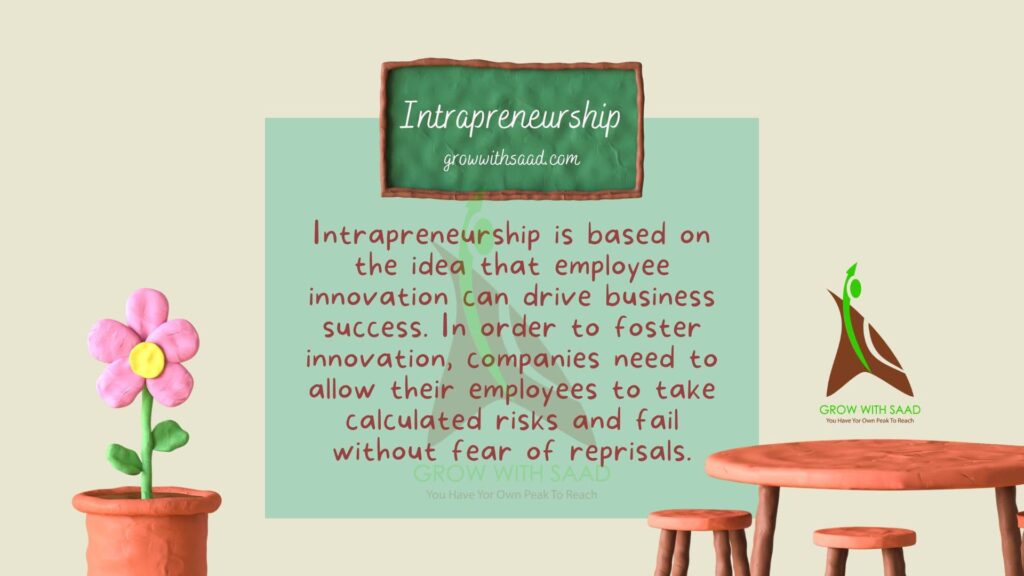Before we begin with the types of corporate entrepreneurship, it is advisable that we first learn what corporate entrepreneurship means.
In order to understand corporate entrepreneurship, you must first understand what it means to be an entrepreneur. An entrepreneur is someone who takes on financial risk and assumes personal responsibility for their actions.
In the corporate world, there are many avenues through which entrepreneurs can work for themselves. This includes starting a new business or working for one of these companies as an employee. Corporate entrepreneurship is often referred to as intrapreneurship because it takes place within a company’s structure (intra = within).
The main difference between corporate entrepreneurs and other types of entrepreneurs is that they have more experience when it comes to working within an organization. They tend to have more knowledge about how things work at their company and therefore make better decisions about what needs to be done to improve efficiency or profits for the company.
Corporate entrepreneurship is actually nothing new. It has been around for decades and has always been around. However, it was never considered an official business model until recently.

Corporate entrepreneurship is a new trend that is gaining popularity. Most people have heard of it, but few understand what it means. Corporate entrepreneurship is the process of using your company as a vehicle for entrepreneurship.
The first thing to understand about corporate entrepreneurship is that it is not for everyone. Many people say that they want to be entrepreneurs, but don’t know how to go about it. Some people even believe that corporate entrepreneurship is more difficult than starting a business from scratch.
Corporate Entrepreneurship
Corporate entrepreneurship is a type of entrepreneurship that involves the involvement of large corporations in small businesses. The corporate entrepreneur will be responsible for managing the business, while the entrepreneur-owner would be responsible for the day-to-day operations.
Also, corporate entrepreneurship is considered to be one of the most beneficial forms of entrepreneurship because it allows people who work in large companies to use their experience and knowledge to create something new while they continue working at their current job.
This type of entrepreneurship allows employees to use their experience and knowledge from previous jobs to create something new for themselves or for someone else who may need help with a particular problem or issue.
Types Of Corporate Entrepreneurship
Now that we learned about the basics of corporate entrepreneurship, let’s learn about the types of corporate entrepreneurship in detail.

Corporate Venturing
Corporate venturing is a type of corporate entrepreneurship that involves starting a new business inside an existing organization. It allows you to test your ideas and launch them into the market before investing all your resources in creating a product that will be successful.
Corporate venturing is a form of growth hacking that makes it easier for organizations to grow their businesses by leveraging existing resources and knowledge.

It also allows you to make use of all the resources and support available at your disposal by entering into an existing company. This means that you have access to capital, marketing, sales, and distribution channels, as well as employees who are already trained and able to help you get started quickly.
Also, corporate venturing is a way to enhance the company’s growth and profitability by taking advantage of its existing resources. This can be done by acquiring other businesses, entering new markets, or expanding their operations in existing markets.
Therefore, corporate venturing can be used to expand an existing business by acquiring another company or by starting a new company within the same organization. It may also involve selling part of an existing business unit or asset to another entity.
Corporate venturing may be used to grow an existing business organically, but it’s also possible for it to be used as a means of creating a new brand from scratch — without having any prior experience running a business. it helps any enterprise venture into new areas by launching new brands or adding innovative products to its existing brands.
For example, the world’s leading luxury giant LVMH acquired Tiffany & Co. for a whopping sum of $16.2 billion to strengthen its luxury jewelry business presence globally.
Intrapreneurship
Intrapreneurship is a type of corporate entrepreneurship that focuses on internal innovation, which is the process of creating new products, services, and business processes through the use of employees.
It is the practice of setting up a new business within an existing organization. It’s about finding ways for employees to take ownership of their work, their company, and its success.

Intrapreneurship is created to set the employees’ minds and behavior to create a culture of creativity. In order to do that, the intrapreneur must be able to motivate his or her team members through innovation and risk-taking. It is important that you don’t just give them a task; you also need to provide them with the tools, authority, and environment needed to complete it successfully.
Types of intrapreneurship that can help any organization get more innovative:
1) Internal Innovation: This involves employees coming up with ideas on how things could be done better within their own organizations.
2) Employee Entrepreneurship: This involves employees starting businesses or other ventures outside their regular job responsibilities.
3) Innovation at Work: This involves creating new ways of doing things within an organization, including setting up new departments or moving into more effective ways of working together as teams.
Intrapreneurs are usually charged with making changes within their own department, but they often seek ways to improve processes throughout the organization as well.
Intrapreneurship is more common in large organizations with a large number of resources available for experimentation, but it can also be used by small companies with limited resources.
Intrapreneurship requires leadership support and empowerment for employees who are given responsibility for making things happen within their own teams or departments.
Organizational Transformation
The employees of a company are also very important in this type of corporate entrepreneurship. They have a great role to play in ensuring that everything goes as planned and according to schedule.

In order to make sure that this happens, it is essential for them to be aware of all the changes that need to be implemented in order to ensure that things go smoothly.
The thought behind such a transformational drive is that the new organizational structure will help in delivering better results to the customers and also be more competitive in the market. This can be done by making some changes in basic functioning patterns such as downsizing, cost-cutting, etc., and the way things are done in such organizations.
Changing Industry Rules
These organizations are working to modify the existing rules and regulations, which is a very challenging task.

If the company does not want to be involved in changing the rules of an existing industry, then it should be able to create its own unique rules for its business. This will help them gain an advantage over their competitors as well as other companies that are also trying to come up with new ideas and opportunities in their respective industries.
This type of setup opens vast opportunities for the organizations involved in the process.
CONCLUSION
With this, we come to an end of this detailed blog on the topic ‘Types Of Corporate Entrepreneurship. We hope you learned through this piece of information what you were looking for.
Don’t forget to share your views in the comments section below.
We’d love to hear from you:)

